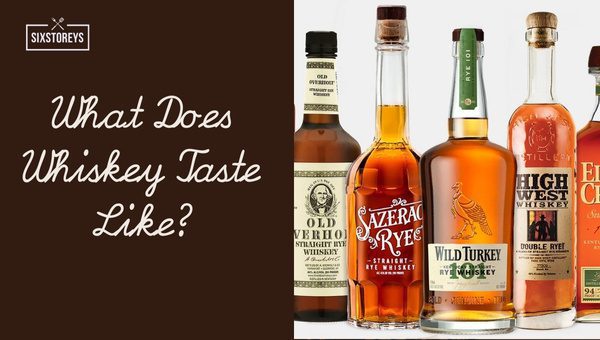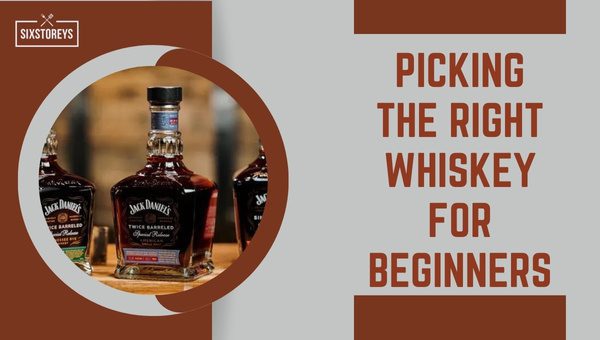What Does Whiskey Taste Like? Beyond the Barrel
Stepping into the world of whiskey is a bit like learning a new language. It has its vocabulary, nuances, and unique expressions that can seem overwhelming at first. This holds true even when you're just trying to understand what does whiskey taste like. Whiskey is a symphony of flavors, encapsulating centuries of tradition, innovation, and craftsmanship in just one sip. It's deep, complex, rich, and full of character. From the subtle sweetness of corn to the caramel notes from the barrel it's aged in, from the warmth that spreads through your chest as it goes down to the smoking peat that lingers on your tongue – every tasting is a journey in itself.
But don't let these complexities deter you. Think of it as tapping into a world full of exciting adventures. One that is as fascinating as it is flavor-filled. This guide will be your companion in the wonderful world of whiskey. So sit back, pour yourself a glass, and let's delve into understanding the delicious symphony of flavors that whiskey has to offer.
Also Read: Best Whiskeys For Hot Toddy
Article Includes
What Does Whiskey Taste Like?

Whiskey, in its essence, tastes like a deep, smooth blend of flavors that takes you on a journey of refined essence steeped in traditions. But the actual flavor can significantly vary depending on its type and how it's made.
Basic Tasting Notes Across All Whiskeys
Regardless of the type, all whiskeys possess some underlying characteristics that define them:
- Sweetness: Most whiskeys have an underlying sweetness.
- Oak: Since whiskey is often aged in oak barrels, a certain degree of this flavor is usually present.
- Heat: Whiskeys are high in alcohol, resulting in a burning sensation, or 'heat,' in your mouth and throat.
- Complexity: Unlike many other beverages, whiskeys have depth and layers in their taste.
Bourbon Whiskey
To put it simply, bourbon can be described as sweet, full-bodied, and rich. The distinctive rich sweetness comes from the fact that it’s made predominantly from corn and aged in new charred oak barrels.
Besides, you'll typically notice flavors like vanilla or caramel, sometimes even cherry and dried fruit. Its finish could be described as oaky or smoky.
Also Read: Best Sweet Bourbons
Rye Whiskey
Rye whiskey has a different flavor profile. It's spicier and has a crisper finish. It often exudes flavors similar to black pepper and cinnamon. It's less sweet than bourbon and can often taste earthy or grainy when compared to others.
Scotch Whiskey
Scotch flavor can be incredibly diverse, depending primarily on its type (single malt, blended malt, single grain, or blended grain scotch) and the region where it has been made. It ranges from light, fruity to rich, dark, and peaty. Some scotches even offer a salty, briny note — an echo of Scotland's rugged coastal regions.
Irish Whiskey
Irish whiskey often presents as smooth, light, and slightly sweet. Thanks to triple distillation and extended aging, it also has a distinctive creaminess. Its flavor notes often include vanilla, cream, and sometimes a slight hint of fruit.
Understanding whiskey taste requires an appreciation of nuances and the vocabulary to articulate it. But most importantly, it needs an open mind and willingness to venture into the unknown, savoring each new discovery!
The Magic of Aging: How it Affects Whiskey's Flavor?

The wonder of whiskey transcends beyond its initial production and ingredients on the distillery floor. In fact, aging is an art of its own, capable of transforming even the simplest base spirit into a beverage rich with complexity.
Aging takes place in oak barrels, a process that imparts invaluable flavors into the whiskey. You've probably heard terms like 'oakiness', 'vanilla', 'spicy', and 'caramel' in the whiskey lexicon. These flavors are largely the result of the interaction of the spirit with the wood over time.
To put it simply, time is whiskey’s best friend. The longer a whiskey continues maturing in the barrel, the deeper and more developed its flavors become. Even the location of the cask in a particular warehouse (the top floor vs. the bottom floor) can have a significant impact on how a whiskey matures. With every passing year, the whiskey draws out more elements from the wood, rounding out its character and amplifying its taste.
But here comes the tricky bit. More aging doesn’t necessarily mean better flavor. Balancing the aging process is key. Over-aging might make the whiskey too woody or tannic. This is why the distiller's craft is an intricate marriage of time, experience, and intuition.
Navigating the Whiskey Flavor Wheel
The flavor wheel, a resourceful tool for whiskey enthusiasts, helps categorize the diversity of flavors that a whiskey may exude. To understand whiskey's flavor, one needs to explore a spectrum of taste notes, from the base grain notes (like corn, barley, and rye) to the influence of aging and maturation process.
The complexity of whiskey's flavor is such that the same glass can taste uniquely different to two individuals. Some might find it sweet and smooth, reminding them of vanilla or caramel. Others might perceive spicier notes, leaning towards a burn that's followed by a pleasant warmth.
Let’s walk through the key elements of the flavor wheel.
Primary Tastes
These are the bedrock flavors directly sourced from the ingredients used to distill the spirit. Malted barley usually gives the whiskey a sweet, cereal-like flavor, rye can add spicy or peppery notes while corn brings a distinctive sweetness.
Aging and Maturation Influences
As we discussed already, aging deeply affects a whiskey's profile. Think dark fruits, nuts, vanilla, toffee, or coffee.
Finish
This is the taste that lingers after swallowing the whiskey. It can be smoky, leathery, sweet, spicy, or dry, depending on the type of whiskey.
Other Tastes
These are miscellaneous tastes that come from specific production methods or the environment. Peat, for instance, gives Scotch its earthy and smoky flavor.
Remember, tasting whiskey is an individual journey that varies from palate to palate. Your flavor wheel might look entirely different from mine, and that’s what makes the process so engaging and exciting.
As they say, the joy of whiskey is in the journey as much as the destination!
Pairing Whiskey: Enhancing Your Tasting Experience

Pairing whiskey with the right food or other beverages can enhance the entire tasting experience by several notches. Kind of like finding the perfect dance partner, the right pairing can perfectly complement the flavors, nuances, and unique character of the whiskey.
If you're starting off, a safe bet would be to pair your whiskey with dark chocolate. They share rich, robust flavors and the creamy sweetness of chocolate can balance out whiskey’s strong, smoky taste.
Ever tried pairing whiskey with cheese? If not, you're in for a surprise. Strong blues, well-aged cheddars, or even the creamy bries work wonders.
For those partial to spicier profiles, spiced nuts and cold cuts can prove to be an excellent match. Nuts enhance the caramel and vanilla tones in the whiskey while cured meats draw out its smoky characteristics.
Moving over to beverages, few things are as quintessentially American as the combination of whiskey and cola. Dive deeper into this realm, and you'll find combinations like whiskey and coffee, which is a match made in heaven for caffeine and whiskey lovers.
Pro tip: As a rule of thumb, vibrant, robust whiskies tend to pair well with similarly strong foods. Delicate, nuanced whiskies typically go well with lighter fare.
The Role of Water and Ice in Whiskey Tasting
While most purists cringe at the thought of diluting their precious amber with water or ice, it's certainly worth exploring. Why? Because adding water or ice can entirely change the battle of flavors waged in your mouth.
Adding Water
When it comes to straight sips, adding a few drops of water - often referred to as "cutting" the whiskey, can surprisingly open up new flavors. It’s like adding a magnifying glass to your whiskey. What was once overpowering can become mild and subtle, revealing underlying notes that your palate could not perceive before. However, it’s crucial to keep the balance. Too much water and you might mute the vibrant symphony of flavors that make whiskey so enjoyable.
On The Rocks
While serving whiskey on the rocks might alter the taste experience, it's a popular method. As ice melts, it gradually dilutes the whiskey, making it a tad sweeter. It also cools it down, slightly numbing your taste buds and subduing the stronger flavors. Plus, there's an undeniable charm about a classically served glass of whiskey on the rocks - it's more about enjoying the experience at a leisurely pace.
Remember: There’s no ‘right’ way to enjoy whiskey. It's entirely up to the individual drinker's preferences. Whether you like it paired with food, neat, with water, or ice-cold, it's all about what makes the whiskey sigh-inducingly delicious for you.
Picking the Right Whiskey for Beginners

If you're new to the world of whiskey, it's easy to feel a little overwhelmed by the sheer number of options on offer. There's a variety of factors such as type, region, age, and price to consider during the selection process. However, fret not. Here are a few guidelines that can help you choose a suitable whiskey to start your tasting journey.
Start with Smooth, Approachable Options
As a beginner, the experience can be smoother when starting with more approachable, less overpowering whiskeys. It's best to avoid cask strength or high ABV whiskeys initially. Instead, aim for selections with an ABV around 40 - 50% as they are easier on the palate. Some smooth, beginner-friendly options include Irish whiskies like Jameson or Bushmills, or a mild Scotch like Glenfiddich 12-year-old.
Fruit-forward and Light
Whiskeys with a fruity, light profile make for great starting points. These whiskies are attractive to the palate and broadly accessible. They're often characterized by sweeter notes of apple, pear, honey, or caramel. Speyside scotches commonly have these flavor characteristics.
Consider the Price Point
Your first whiskey doesn’t need to break the bank. There are plenty of delicious, quality whiskies available at reasonable prices. As a general rule, anything priced between $30-$50 is a good place to start.
Try a Whiskey Tasting Set or Sampler
A whiskey tasting set or sampler is a great investment for beginners. These kits usually include small bottles of different whiskey types, allowing you to experience a range of flavors without committing to a full-sized bottle.
Attend a Whiskey Tasting
Attending a whiskey tasting can be a fun and interactive way to find a whiskey you enjoy. You'll get to learn from knowledgeable guides, ask questions, and discover your preferences.
Also Read: Best Whiskeys for Whiskey Sours
Frequently Asked Questions
What is whiskey made from?
Whiskey is primarily made from grain - usually barley, corn, rye, or wheat. The grains are milled, mixed with water, and then fermented. This mix is then distilled and aged in wooden barrels, commonly oak, which gives whiskey its distinct flavor.
What does 'peaty' mean in whiskey terminology?
'Peaty' refers to a smoky flavor that comes from using peat smoke to dry malted barley. This is commonly found in Scotch whiskies, especially those from Islay.
Does ice ruin whiskey?
Not necessarily. Some whiskey enthusiasts believe adding ice can dull the flavors. However, others argue that a small amount of chilled water can open up the whiskey's aromas and make it easier to detect individual flavors.
What does whiskey taste like to a beginner?
For a beginner, whiskey might taste strong, and the alcohol may overwhelm the other flavors at first. However, with time and practice, you'll begin to pick up the more subtle notes of sweetness, spice, smoke, or fruit.
Are all whiskies smoky?
No, not all whiskies are smoky. The smoky flavor comes from the malting process where smoke from peat is used to dry the malted barley. Only certain types of whiskies, like some Scotch whiskies, have this smoky flavor.
What does a 'smooth' whiskey taste like?
When people describe a whiskey as 'smooth', they’re referring to the absence of a harsh, burning sensation when swallowing. A smooth whiskey is easy to drink, with balanced flavors that blend well together.
How do I develop my palate for whiskey tasting?
Start slow. Begin with whiskies that are lighter and smoother, then gradually move onto stronger, more complex whiskies. Take the time to truly taste – noting the aromas, flavors, and aftertaste. Over time, you'll start picking up on various flavor profiles.
How do I drink whiskey to get the full flavor?
Sip, don’t gulp. Allow the whiskey to sit in your mouth for a moment before swallowing. This will enable your taste buds to register the flavors. Take your time and engage all your senses.
Conclusion
Whiskey, in all its complexity and depth, offers a multi-faceted world of flavors that is truly one-of-a-kind. This little guide to understanding whiskey is just a drop in the ocean of experiences out there. You may start your journey as an amateur, but with every sip and with every different bottle, you'll become a little more familiar with the nuances and range of tastes and aromas whiskey can offer.
Remember, the language of whiskey is a playground of tastes, not a rulebook. It's all about personal experience and enjoyment. So, don't be overwhelmed. Just open a bottle, pour a dram, and let your palate explore. You'll find that the question 'what does whiskey taste like?' leads to surprising, satisfying and exciting discoveries. After all, the beauty of whiskey is that it's a lifelong journey, offering new things to learn and discover at every turn. Cheers to your new adventures in the world of whiskey!
